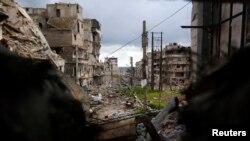The World Health Organization warns that millions of people in Syria are facing a health crisis. It says deaths and casualties are mounting in the war-torn country as medical care and treatment diminish.
The World Health Organization’s representative in Syria was on a three-day visit to Aleppo when a square in the city center was hit by mortar fire, causing severe injury among children and other civilians.
Speaking by telephone from Damascus, Elizabeth Hoff says she was visiting Al Razi hospital shortly after scores of war-wounded people were brought in this past Monday. Hoff says she found the experience very difficult and moving.
“For me, I was very disturbed by the high number of young people losing their arms and legs and what happened here. I also went for a photo-op visit the next day and I saw this high number of young people who had actually been touched severely and had their lives really being totally turned upside down by what had happened in the square the day before," said Hoff.
Hoff says three children, ages 3, 7, and 9, died during the attack. She says she was very impressed by the care patients received, considering the shortage of health personnel and the hardships under which they have to operate.
The WHO estimates more than 1.3 million people in Aleppo need health assistance, but only four out of 11 public hospitals remain in operation. It says all health facilities are overcrowded, experience critical shortages of medical supplies and depend upon generators for electricity.
Across Syria, the WHO notes 57 percent of public hospitals are either partially functioning or are completely out of service. It says local production of medicines has been reduced by 70 percent and many life-saving treatments are not available. Furthermore, it says there now are around 45 percent fewer health professionals available than in 2011 when the war began.
Hoff warns of an increased risk of waterborne diseases as the weather becomes warmer. She says new cases of Hepatitis A are occurring every week because of the lack of safe water. Hoff also says she fears a cholera outbreak as temperatures rise.
“Another issue is really linked to the vaccination coverage. It has dropped. It used to be one of the highest in Syria. They had 90-percent vaccination coverage, but today it is between 50 and 60 percent," she said. "We are now very concerned about the routine vaccination."
Despite the many difficulties, the WHO, with the help of local partners, is providing supplies to all parts of the country. Last year, it was able to deliver more than 13.8 million treatments, almost one third to hard to reach and opposition-controlled areas. So far this year, the WHO says nearly 4.7 million people have received health assistance.
The U.N. health agency and its partners need $687 million for humanitarian operations on behalf of 16 million people inside Syria and in neighboring countries this year. So far, it says, they have received virtually no new funds to support their life-saving activities.








